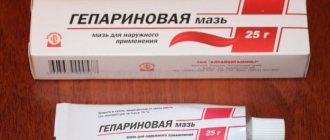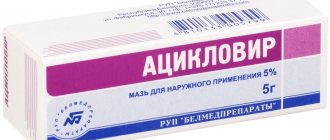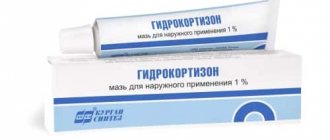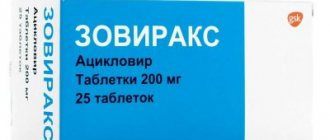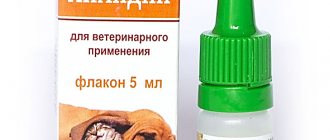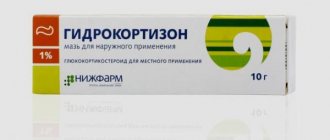Erythromycin ointment is a broad-spectrum antibacterial agent. It stops the development of infectious processes, showing primary activity against gram-positive flora, but also affects some types of gram-negative flora, preventing reproduction. Manufactured by Russian pharmaceutical companies located in various regions.
pharmachologic effect
Erythromycin is an antibiotic that belongs to the group of macrolides. It has a bacteriostatic effect on the patient's body. The drug has an effect on gram-positive bacteria (Streptococcus pneumoniae, Staphylococcus spp., Bacillus anthracis, Streptococcus spp., Corinebacterium diphtheriae, Clostridium spp.).
The drug also acts on certain gram-negative microorganisms. However, most gram-negative bacteria, as well as fungi, medium and small viruses, are resistant to the effects of Erythromycin.
Patients tolerate Erythromycin better than penicillins . Therefore, the drug can also be prescribed in case of allergy to penicillins. When treated with the drug, resistance of microorganisms to it develops relatively quickly.
How to store
It is easy to store the product at home. It is best to place the tablets and vials of lyophilisate in the original packaging and store them in a dark, dry drawer or chest of drawers at room temperatures. The eye ointment must be stored with a tightly closed cap, also in the original packaging, on one of the shelves in the refrigerator door.
The worst storage conditions are: rooms with high humidity, shelves and places with constant exposure to sunlight, storage with the cap uncorked.
Analogue drugs:
- Altrocin-S;
- Azax;
- Azibiot;
- Azimed;
- Azithrogexal.
Indications for use
Erythromycin ointment is used to treat infectious and inflammatory diseases caused by microorganisms sensitive to erythromycin. It is used in the treatment of infectious and inflammatory diseases that were provoked by pathogens that exhibit resistance to tetracyclines , chloramphenicol , penicillin , streptomycin .
Externally used to treat juvenile acne .
Local use of drugs is indicated for infectious and inflammatory eye diseases.
Erythromycin ointment is also prescribed for the treatment of trachoma, inflammatory processes of the mucous membrane of the eyes, for the treatment of pustular diseases of the skin, bedsores of infected wounds, burns, trophic ulcers.
Indications and contraindications
Erythromycin ophthalmic ointment is prescribed for bacterial inflammatory processes - conjunctivitis, blepharitis, keratitis, and is used to treat trachoma, including in infants.
Indications for external use:
- infected wounds and postoperative scars;
- dermatological processes in which ulcers form - including boils, phlegmon;
- bedsores at the inflammation stage;
- burns 1 – 3 degrees;
- trophic ulcers.
Erythromycin gel is used to prevent and treat acne. With its help, you can stop the development of inflammation and prevent exacerbation. The ointment helps with rosacea - for this disease, erythromycin is considered the most effective antibiotic.
Absolute contraindications: allergy to active or auxiliary components, severe liver and kidney pathologies, history of hepatitis. Use external agents with caution during pregnancy and lactation.
Side effects
When treated with Erythromycin ointment, the following side effects may develop:
- irritant effect causing itching, redness;
- other allergic manifestations ;
- disorders of the digestive system: vomiting, nausea, diarrhea, dysbacteriosis, etc.;
- candidiasis;
- tinnitus and hearing loss;
- tachycardia.
With prolonged treatment, it is possible to develop a secondary infection, which was provoked by microorganisms resistant to erythromycin .
Overdose and side effects
Erythromycin is an unusual, unique drug. One of those that causes minimal harm to human well-being and health, this is the main reason that no overdose has been recorded.
In addition, a striking difference between erythromycin and similar drugs is better absorption in the human body. Having a whole list of beneficial, safe effects on the body, erythromycin ointment also has side effects.
Conditions were repeatedly recorded: burning, itching, redness. However, these phenomena tend to disappear. If, after half an hour, the above symptoms have not gone away.
Use of the ointment should be discontinued. If burning, itching and redness are observed two days after using the ointment, consult a doctor immediately.
Instructions for use of Erythromycin ointment (Method and dosage)
The instructions for Erythromycin ointment stipulate that before prescribing the drug, the level of sensitivity to the ointment of the microflora that provoked the development of the disease should be determined. The eye ointment is applied to the lower or upper eyelid three times a day, and its amount is 0.2-0.3 g. If the patient is diagnosed with trachoma, the product should be applied 4-5 times a day.
Instructions for use of Erythromycin ointment indicate that the duration of treatment depends on the severity of the disease and the effectiveness of treatment. In most cases, treatment lasts from one and a half to two months. For trachoma, the course of treatment increases to 4 months.
For skin diseases, the drug should be applied to the affected areas 2-3 times daily. In the process of treating burns, the drug is used 2-3 times a week. The product should be applied in a fairly thin layer, treatment can last from 3-4 days to two weeks.
The doctor can change the duration of the course of treatment or dosage on an individual basis, depending on the diagnosis and characteristics of the course of the disease.
Description of the drug
Erythromycin ointment is non-toxic and can be freely used to treat any part of the body. The medication is highly tolerable, which is why it is often prescribed to patients with a severe allergic reaction to penicillin antibiotics. The medicine is used for eye pathologies, skin inflammations, diseases localized in the nose, for the treatment of burns and purulent wounds.
The drug is recognized as one of the best for treating acne in adults and children. In complex therapy of infectious pathologies, it is necessary to combine erythromycin tablets and gel, which have a beneficial effect on the condition of the skin.
The medicine includes an antibacterial active ingredient, so the ointment is used in short courses in order to eliminate the possibility of pathogens becoming addicted. Treatment begins only after consultation with a doctor. The doctor will give important instructions on taking the medication, taking into account the severity of the lesion, the presence of adverse reactions in the patient, and neutralize the danger of associated complications.
Clinical and pharmacological group
Erythromycin eye ointment belongs to the pharmacological group of macrolide antibiotics, antiparasitic and antimicrobial agents.
Pronounced liniment activity manifests itself in relation to:
- chlamydia;
- streptococci;
- corynebacteria;
- Haemophilus influenzae;
- staphylococcus.
The antibiotic inhibits many bacterial strains that are inert to other medications. With prolonged therapy, the pathogenic microflora becomes inert to erythromycin.
pharmachologic effect
When applied locally, the bacteriostatic cream exhibits an antibacterial and anti-acne effect. The activity of the active substances extends to gram-negative and gram-positive pathogens.
Pharmacokinetics and pharmacodynamics
Erythromycin ointment for external use is quickly absorbed by the skin and easily penetrates the pleural cavity, lymph nodes, lungs and other tissues. It is eliminated from the body naturally. The level of concentration of residual products in urine is several times higher than the content of active substances in blood plasma.
At high concentrations it has a pronounced bactericidal effect. Targeted suppression of pathogen activity is achieved through a simple mechanism:
- the active elements of the antibacterial drug enter into a chemical reaction with the fishsome compound 50S;
- the synthesis of peptide bonds between neighboring amino acids at the molecular level is disrupted;
- the production of new protein structures is inhibited.
In fact, pathogenic microorganisms lose their ability to reproduce; as for nucleic acids, their synthesis takes place without any adjustments.
The medication does not affect vital functions:
- mycobacteria;
- fungal structures;
- viral pathogens;
- several subspecies of gram-negative bacteria.
The ointment is prescribed during a course of treatment as part of complex therapy. With prolonged exposure, it becomes addictive in microorganisms and loses its medicinal properties.
Release form and composition
The drug is available in the form of tablets, ointment and gel. Gel and ointment are used exclusively externally, through local treatment of the problem area of the body. The ointment is yellow-brown in color and has a medium thick consistency. The medicine is supplied in laminate and aluminum tubes of 3, 5, 7, 10 and 15 g. Some manufacturers produce the composition in 30 g glass jars. Each tube comes with annotation and instructions for use.
The composition of liniment includes several active components:
- erythromycin - the main element of the ointment, is a broad-spectrum antibiotic, the concentration is 1000 units;
- Vaseline is the basis of the drug;
- lanolin;
- sodium disulfite and pyrosulfite.
The drug has a distinct, specific odor. Auxiliary ingredients increase the activity of the antibiotic and allow it to penetrate deep tissue structures.
Storage conditions and periods
It is recommended to store erythromycin ointment in a cool place protected from sunlight at a temperature of +5 to +25 °C. It is important that the packaging with the drug is out of reach of children. In sealed packaging, the shelf life of the medication is 36 months. After opening the package – up to 1.5 months. If the integrity of the packaging is compromised, it is safer to refrain from purchasing the medicine.
Interaction
If Erythromycin is used simultaneously with Aminophylline , caffeine , Theophylline , then the plasma concentration of the latter increases. As a result, the risk of toxic effects increases.
Erythromycin increases the concentration of cyclosporine in the blood, thereby increasing the likelihood of nephrotoxicity.
Agents that block tubular secretion increase the half-life of erythromycin.
Antibiotics of the erythromycin series are not compatible with Clindamycin , Lincomycin , Chloramphenicol . Under the influence of erythromycin, the bactericidal effect of beta-lactam antibiotics .
Simultaneous treatment with Erythromycin and Theophylline increases the level of the latter.
If concomitant treatment with erythromycin and drugs that are metabolized in the liver is carried out, the concentration of these drugs in the blood plasma may increase.
Erythromycin reduces the effectiveness of hormonal contraceptives .
The simultaneous use of Erythromycin ointment and abrasive substances that irritate the skin or provide exfoliation leads to a drying irritant effect.
special instructions
After using Erythromycin, at least one hour should pass before using another external acne remedy.
If acne does not improve after 3-4 weeks of regular use of the ointment, you should consult a specialist. In some cases, a pronounced effect is observed only after 2-3 months of using the ointment.
If the product is used for a long time, superinfection may develop.
If eye ointment is used to prevent ophthalmia , it should not be washed out of the eye.
For children whose mothers have been diagnosed with severe gonorrhea , erythromycin as an ophthalmic drug is prescribed simultaneously with an aqueous solution of penicillin G (parenteral use).
Use during pregnancy, lactation and for children
This is a fairly safe drug for the human body among antibiotics. The use of erythromycin ophthalmic ointment is acceptable during pregnancy, during breastfeeding and for the treatment of newborns and children.
However, you should consult your doctor about the rules of administration and the need to use erythromycin.
Systemic studies have been carried out in incomplete quantities. And they do not allow us to assess the harmful effects the medicine has on the fetus.
Therefore, erythromycin should not be used in the first half of pregnancy.
During lactation, treatment with the drug is not recommended. The antibiotic passes into breast milk. For women with infants, it is wiser to choose other medications for the treatment of eye diseases with their doctor.
For children, erythromycin ointment is approved almost from birth. An important circumstance will be the availability of medical permission. The drug erythromycin is acceptable for the treatment of eye inflammation in infants.
The actions provided to them help in getting rid of infections received when the baby passes through the birth canal. But! Erythromycin - for topical use - is not prescribed to children with jaundice.
Medical experts say that it is permissible to use medicinal drugs only when the risk of a possible complication from the drug is lower than the risk of the consequences of the disease.
https://medglaza.ru/aptechka/mazi/eritromitsinovaya-instruktsiya.html
Analogs
Level 4 ATC code matches:
Zinerite
Dalatsin
Zerkalin
Klindovit
Erythromycin
Analogs of Erythromycin ointment are Tetracycline ointment , drugs Ciplox , Dex-Gentamicin , Tobradex .
Tobradex
The drug is presented in the form of drops. Similar to Tobradex in terms of its effect on pathological areas. The cost of the drug is 447 rubles.
Erythromycin-based ointment analogues are characterized by a wide range of effects on the pathological microflora of the eyes.
Author's rating
Author of the article
Alexandrova O.M.
Articles written
2031
about the author
Was the article helpful?
Rate the material on a five-point scale!
( 2 ratings, average: 3.00 out of 5)
If you have any questions or want to share your opinion or experience, write a comment below.
Reviews of Erythromycin ointment
There are numerous reviews on the Internet about Erythromycin ointment, which most often refer to the use of this remedy for acne. It is noted that this medicine helps get rid of acne quite effectively by preventing the effects of bacteria.
However, there are reviews in which it is noted that Erythromycin ointment, after prolonged use, did not have the expected effect. Doctors emphasize that the ointment should be used to treat acne and other diseases according to a clear scheme and only after consultation with a specialist. Since the drug is an antibiotic, its use should be taken wisely.
Release form and composition
Dosage forms of erythromycin ointment - for eyes and external use. The active component is the same - erythromycin, an antibiotic from the macrolide group, 10,000 units / 1 g. Auxiliary components in the ophthalmic product - lanolin, mineral oil, sodium metabisulfite; for skin - the composition is supplemented with petroleum jelly. Therefore, eye ointment is yellow or light yellow in color, and the drug used in dermatology is brown, with a greenish tint.
Dosage forms also differ in the color of the packaging. White cardboard packs of eye ointment have blue stripes, and skin ointment has green stripes. The metal tubes in which the drugs are packaged have the same design.
For use in dermatology - for the treatment of acne, skin rashes, perioral dermatitis - they began to produce erythromycin gel.
Instead of Vaseline, it contains zinc acetate. The consistency is light, the adsorption is high, the color is light yellow. There is a two-color stripe on the packaging and pack - blue and green. Price - from 35 rub.
